It always rains in Wales doesn’t it? It’s the land of raging rivers and brim-full lakes isn’t it? England’s holding tank, a place where wet feet are guaranteed. No, not at the moment it isn’t. Right now, it’s the land of trickles and baked hard mud; the driest summer in living memory has left the green hills singed and gasping for water like a fish on the canal side …. ideal conditions to be testing a packraft then!
I introduced the Longshore EX280 packraft on these very pages a few weeks ago. At that time my packrafting experience went as far as having inflated one but I was excited by the prospect of what lay ahead. Maps studied, the internet browsed and plans formulated in an effort to make the most of our short time together. I bought a personal flotation device, which I hoped wouldn’t be needed and located my long lost paddle from the barn only to discover they were in fact a pair of canoe paddles which couldn’t be joined … obviously the designers had never bargained on the power of raw excitement combined with Gorilla tape and the old length of hoover pipe I found.
I was set, all requirements met, everything I needed was in place apart from one very vital component, without which, I was going to struggle to fulfil my nautical ambitions – water. The two reservoirs I had earmarked were shallow, muddy shadows or their usual selves, their contents now on the wrong side of Shropshire. Undeterred, I moved my gaze towards the gentler flowing rivers but again my search was fruitless. Many of the smaller ones were simply too low and those larger ones that weren’t drier than a Lidl Muscadet appeared to have all access points monitored by GCHQ and policed by some kind of armed and grumpy waterway militia. I could have gone to the coast, there’d be minimal access restrictions and abundant water but there would be an ever present fear of appearing on the news after a widespread search and rescue operation because my paddle fell apart. With both time and options running out, I headed for Glaslyn – the Blue Lake. It had water in it, no one would care if I was there or not and according to legend, it has no bottom – not ambitious but given the circumstances, a perfect start.
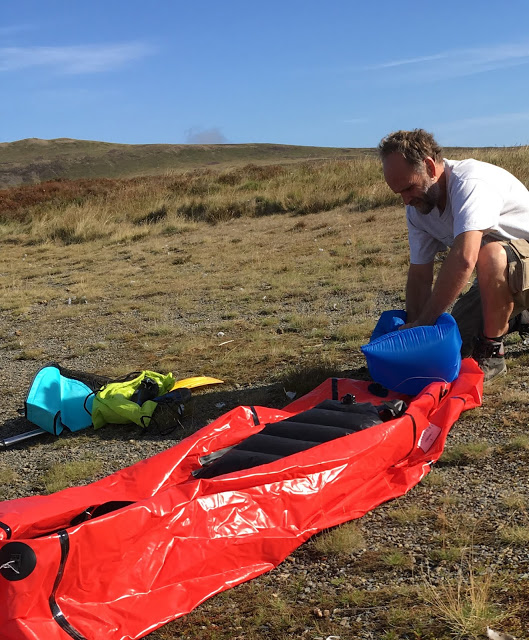 |
| Bag to boat in less than 5 minutes, however I’m sure it can be done much faster. |
Upon reaching the shore, the first job was to inflate the thing. I’d had a little practice by now so remembering to inflate the seat first, I had a water worthy craft in less than five minutes. Just like anything that’s filled with air and I’m thinking inflatable sleeping mats as an example, packrafts can lose a little pressure as the air inside condenses after it comes into contact with the colder water. A few minutes of ‘tempering’ is called for; simply place the inflated raft in the water and allow it to stand for a while, then top up the air as required. You’ll be wanting to make sure you’ve secured the raft somehow to prevent it drifting away before you wonder off to look at all the pretty shiny pebbles … won’t you?
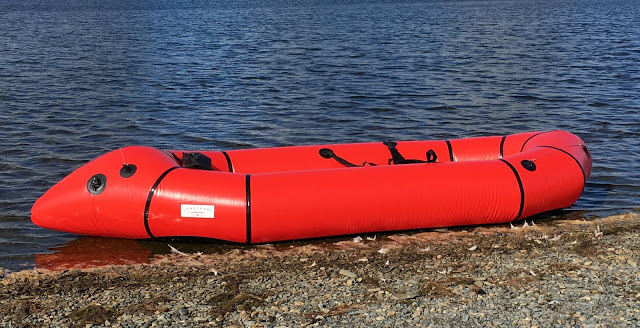 |
| A few minutes ‘tempering’ to allow the air inside the raft to condense. |
Rather luckily, getting in was made relatively easy in this case. Simply move the raft into a few inches of water then slide your way over the tubes and in. Things may be a little trickier if launching from a high banking or similar but in this instance I was happy to set sail with my dignity in tact. I’m told that it is possible to stand directly on the floor and I’m sure you can but I imagine always trying to limit doing so would be wise.
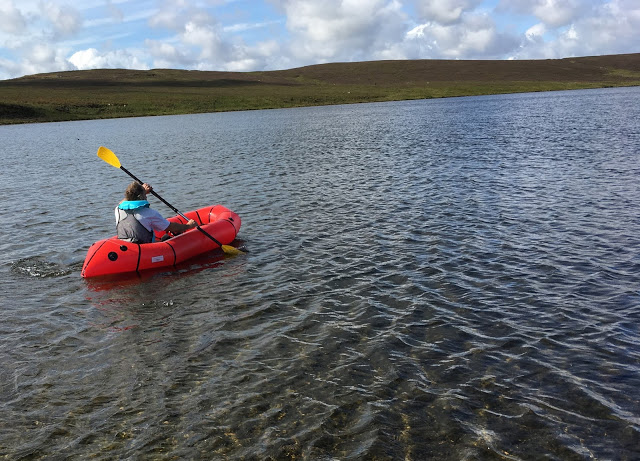 |
| … and off I go. You can see the bow slightly raised. Luggage or a passenger would level things out nicely. |
The first thing I noticed was how stable everything felt. The second thing I noticed was how well it paddled. I’d read numerous reports stating that generally packrafts don’t paddle well but I assume many were penned by those with much more experience with paddle-powered transport than me. As a novice, I found it fine, in fact better than I anticipated. It appeared to go where I wanted it to and at a speed that seemed a fair trade for the effort required. As a potential two person raft being piloted by one, I had expected to encounter a certain amount of yaw at the front … think of it as oversteer with the unweighted bow pivoting around me at the stern with each paddle stroke. There was a little but it was easily compensated for and I’m sure what little there was would be negated by the addition of luggage or passenger.
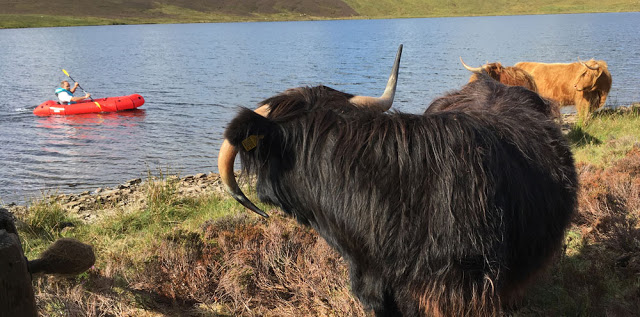 |
| These lot … not bad swimmers. |
It really was a day of surprises. Not only was it more stable than I imagined and paddled better than anticipated, it was also much comfier than I thought it might be. I didn’t feel that I had to physically hold myself in any fixed position and simply allowed the seat and backrest to support me, in truth the more I relaxed and allowed the seat to do its job, the comfier it became. I thoroughly tested the maneuverability after straying a little too close to the woolly bully on the shore and discovering that they’re not scared of water. Fortunately, the raft’s ability to quickly change direction proved better than their swimming technique.
Although I’ve looked across this particular lake more times than I can recall, it quickly became apparent that I didn’t know it like I thought I did. A hidden shingle ‘beach’ unseen from any track and unreachable or certainly very unpleasant to visit overland was soon added to my mental list of over-night spots. I’d never have found it any other way and that is probably where the beauty of a packraft lies; it opens up opportunities that without it, simply don’t exist. I also discovered something else that a packraft can do … it can make you smile! I’ll admit that I was a little worried when it first came over me; an unusual feeling in my jaw, then a tightening of the skin around my mouth. At first I put it down to my dodgy wisdom tooth moving again but after a few minutes, I realised it was a smile and it was there simply because of what I was doing – those who know me will fully appreciate how remarkable that really is.
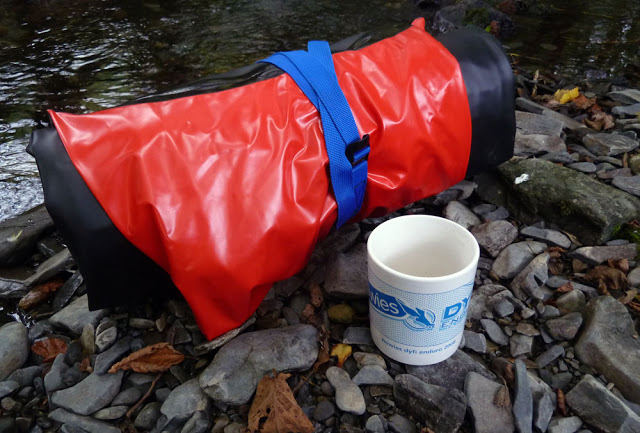 |
| Think of it in terms of a bar-roll and you’ve found it somewhere to live. |
Taking a packraft is always going to be heavier and require more packing volume than not taking one – but how much more? The EX280 is the biggest raft in the Longshore range. On my scales the entire raft including both seats came in at 4kg give or take a few grams. It is not the lightest thing in the world but given the opportunities it represents, it’s not too heavy to take. After some practice, I was able to reliably pack it to a size that would fit most bar harnesses and certainly strap directly to the bars of most bikes. Yes, you are also going to require a paddle and pfd but the weight of those will largely depend on the depth of your pockets or your ingenuity and solutions will differ person to person. As already mentioned, I bought an inflatable pfd which weighs 300g, packs small and would easily double as a pillow. My paddle was somewhat heavier, something no doubt compounded by my liberal use of tape and vacuum cleaner parts but a 4 section paddle could I’m sure, be used in place of tarp poles helping to offset some of the weight.
If, or as is far more likely – when I buy a raft, I will probably look at the Longshore SL260. It’s smaller than the EX280, so weighs around 1kg less and packs to around three quarters of the size – It’s also £65 cheaper. However, if I expected company on a regular basis or didn’t intend to carry my raft very far, I’d have no hesitation in buying the larger EX280 and fully exploiting the increased carrying capacity. No ‘proper’ packraft is cheap but from what I can see, the Longshore rafts seem to represent very good value for money. I can’t fault the quality or the functionality and the ability to deal with and buy directly from someone in the UK is a real bonus … especially if you’re not particularly ‘clued up’ like me.
Longshore Int

Great stuff. I don't think I've ever seen long haired cows in Wales either, so that's a bonus. 🙂
It's scary that these things have only a single buoyancy chamber, especially considering their lightweight construction. As such they don't comply within any marine safety classification, not even the RCD D category for small lakes ans sheltered bays. A leak will result in the whole thing sinking, unlike any commercial inflatable boat which has at least two chambers to ensure reserve floatation.
Hi Paul,
I own Longshore International packrafts.
You are right, most packrafts on the market have a single chamber – this is because it makes them easier to inflate and deflate and reduces weight. However they also have additional buoyancy chambers in both seats and the backrest.
Under the Recreational Craft Directive, packrafts fall into the same classification as 'human powered' canoes and kayaks, which are not required to adhere to the same restrictions as say a sailing boat or RIB because of their different nature and use. As with paddling a canoe, kayak or SUP we recommend you always wear a personal flotation device.
Packrafts are tough little boats which were originally designed for whitewater, as I can testify having spent the last three days throwing a self bailing model around Class 4 rapids in Slovenia and bouncing of rocks all the way down the river.
That said we are happy to manufacture a packraft with two chambers if a customer would like it. Packrafts have been taken to some amazing places and put through incredible trials; for anyone interested, I'd highly recommend Roman Dial's book or just researching packrafts on Google to get a feeling for what these tough little boats are capable of.
Best wishes,
Tim